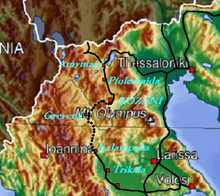Palaiofarsalos–Kalambaka railway
The Palaiofarsalos to Kalambaka railway is a standard-gauge railway line that connects Kalambaka with the mainline station of Palaiofarsalos in Thessaly, Greece.[1] Originally opened as a metre-gauge railway in 1886, it was converted to standard gauge in 2001.
| Palaiofarsalos-Kalambaka railway | ||||||||||||||||||||||||||||||||||||||||||||||||||||||||||
|---|---|---|---|---|---|---|---|---|---|---|---|---|---|---|---|---|---|---|---|---|---|---|---|---|---|---|---|---|---|---|---|---|---|---|---|---|---|---|---|---|---|---|---|---|---|---|---|---|---|---|---|---|---|---|---|---|---|---|
 | ||||||||||||||||||||||||||||||||||||||||||||||||||||||||||
| Overview | ||||||||||||||||||||||||||||||||||||||||||||||||||||||||||
| Type | railway line | |||||||||||||||||||||||||||||||||||||||||||||||||||||||||
| Status | Operational | |||||||||||||||||||||||||||||||||||||||||||||||||||||||||
| Locale | Greece (Thessaly) | |||||||||||||||||||||||||||||||||||||||||||||||||||||||||
| Termini | Palaiofarsalos 39.3142°N 22.2432°E Kalambaka 39.7030°N 21.6254°E | |||||||||||||||||||||||||||||||||||||||||||||||||||||||||
| Stations | 7 | |||||||||||||||||||||||||||||||||||||||||||||||||||||||||
| Operation | ||||||||||||||||||||||||||||||||||||||||||||||||||||||||||
| Opened | 1886 (metre gauge) 2001 (standard gauge) | |||||||||||||||||||||||||||||||||||||||||||||||||||||||||
| Owner | OSE | |||||||||||||||||||||||||||||||||||||||||||||||||||||||||
| Operator(s) | TrainOSE | |||||||||||||||||||||||||||||||||||||||||||||||||||||||||
| Technical | ||||||||||||||||||||||||||||||||||||||||||||||||||||||||||
| Line length | 80.44 km (49.98 mi)[1] | |||||||||||||||||||||||||||||||||||||||||||||||||||||||||
| Number of tracks | Single track[1] | |||||||||||||||||||||||||||||||||||||||||||||||||||||||||
| Track gauge | 1,435 mm (4 ft 8 1⁄2 in) standard gauge | |||||||||||||||||||||||||||||||||||||||||||||||||||||||||
| Electrification | No[1] | |||||||||||||||||||||||||||||||||||||||||||||||||||||||||
| Operating speed | 100 km/h (62 mph) (highest) | |||||||||||||||||||||||||||||||||||||||||||||||||||||||||
| ||||||||||||||||||||||||||||||||||||||||||||||||||||||||||
Route
The southern terminus of the line is Palaiofarsalos railway station near Farsala. Here, the line separates from the Piraeus–Platy railway and follows a branch of 80.44 km (49.98 mi). It continues to Karditsa and Trikala, and advances north-northwest to the northern terminus in Kalambaka.
The duration of the regular stopping service between Athens and Kalambaka is 4 hours and 11 minutes, but faster travel times can be achieved by taking the InterCity service to Thessaloniki and changing trains at Palaiofarsalos.[2]
Stations
The stations on the Palaiofarsalos-Kalambaka railway serve are:
History
The metre-gauge railway from Palaiofarsalos to Kalambaka was inaugurated on 16 June 1886 as part of the Thessaly Railways, with services to and from Volos.
After the First World War, the Greek state had planned the ambitious construction of several new rail lines and links, including a standard gauge line from Kalambaka on to Kozani and then Veroia creating a conversion of the route from Volos to Kalambaka on standard gauge. In 1927, the relevant decisions were made, starting in 1928, work was carried out on the construction of the new line from Kalambaka. But a year later, it was clear that the project would exceed the estimated costs many times over. In 1932, the construction work was stopped and remains unfinished.[3]
Freight traffic declined sharply when the state-imposed monopoly of OSE for the transport of agricultural products and fertilisers ended in the early 1990s. Many smaller stations on the network (with little passenger traffic) were closed, especially on the mainline section between Karditsa and Kalampaka.
In early 2001, the decision was taken to upgrade the line from 600 mm gauge to standard gauge and physically connected at Palaiofarsalos with the mainline from Athens to Thessaloniki. In 2001 the section between Kalampaka and Palaiofarsalos was converted from 600 mm gauge to standard gauge and physically connected at Palaiofarsalos with the mainline from Athens to Thessaloniki.[4] Since to upgrade, however, travel times improved and the unification of rail gauge allowed direct services, even InterCity services, to link Volos and Kalambaka with Athens and Thessaloniki. During the conversion, several smaller stations where closed, however, travel times improved and the unification of rail gauge allowed direct services, even InterCity services, to link Kalambaka with Athens and Thessaloniki.
Services
The Palaiofarsalos-Kalambaka railway is used by the following passenger services:
- Proastiakos Palaiofarsalos-Kalambaka. The journey takes around 48 mins.[5]
Future

Upgrade
In early 2018 TrainOSE announced the upgrade of the line.[6] This upgrade will involve doubling the track and full electrification from Kalambaka (allowing faster nonstopping services to Athens and Thessaloniki) with installation of new signalling and ETCS Level 1 systems on the existing single-track railway line.[6] The tendering process was set for 11 October 2018, with funding being allocated Operational Programme THESSALY 2014-2020.[6] With a completion date of 2022. The time for Athens to Kalampakas will be reduced to 2 hours and 50 minutes, Athens to Karditsa 2 hours and Athens to Trikala 2 hours and 40 minutes.[7] The projected costs estimate are set at €46,6500.[6]
Extensions
East: Kalambaka - Grevena - Siatista - Kozani - Panagia Soumela Vermiou - Veria According to press reports, there is OSE's planning for line extensions, from Kalambaka to Grevena, Siatista and Kozani at first stage
West: Kalampaka-Ioannina-Igoumenitsa (project duration from the completion of the study: 5 years). In the projected second stage expansion from Kalambaka to Ioannina and Igoumenitsa in the framework of the Railway Egnatia.[8] The expansion stations will be: Kalambaka-Malakasi-Anthochori-Ioannina-Kastritsa-Agios Nikolaos-Kristallopigi-Igoumenitsa.[9]
References
- "Network Statement Validity: 2020 ANNEXES". Athens: OSE. Retrieved 17 August 2020.
- "TRAINOSE ticketing". TrainOSE. Retrieved 17 August 2020.
- Alexandros C. Gregoriou Archived [Date missing] at gregoriou.itgo.com [Error: unknown archive URL]
- https://www.ergose.gr/project/anavathmisi_grammis_palaiofarsalos_kalambaka/?lang=en
- https://www.rome2rio.com/s/Palaiofarsalos/Kalambaka
- https://www.ergose.gr/project/simatodotisi_ilektrokinisi_palaiofarsalos_kalampaka/?lang=en
- "Archived copy". Archived from the original on 2018-11-22. Retrieved 2018-11-22.CS1 maint: archived copy as title (link)
- https://www.ypodomes.com/index.php/statheri-troxia/sidirodromoi/uperastikos-ose/item/33747-%25CE%25AD%25CF%2581%25CF%2587%25CE%25BF%25CE%25BD%25CF%2584%25CE%25B1%25CE%25B9-%25CF%2583%25CE%25B9%25CE%25B4%25CE%25B7%25CF%2581%25CE%25BF%25CE%25B4%25CF%2581%25CE%25BF%25CE%25BC%25CE%25B9%25CE%25BA%25CE%25AC-%25CE%25AD%25CF%2581%25CE%25B3%25CE%25B1-15-%25CE%25B4%25CE%25B9%25CF%2582-%25CE%25B5%25CF%2585%25CF%2581%25CF%258E-%25CF%2583%25CF%2584%25CE%25B7%25CE%25BD-%25CE%25B5%25CE%25BB%25CE%25BB%25CE%25AC%25CE%25B4%25CE%25B1
- http://library.tee.gr/digital/kma/kma_m1310.pdf